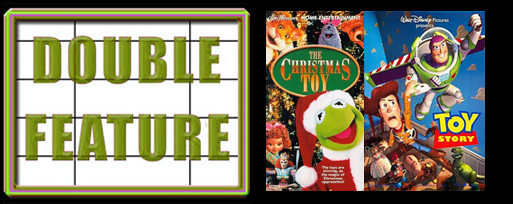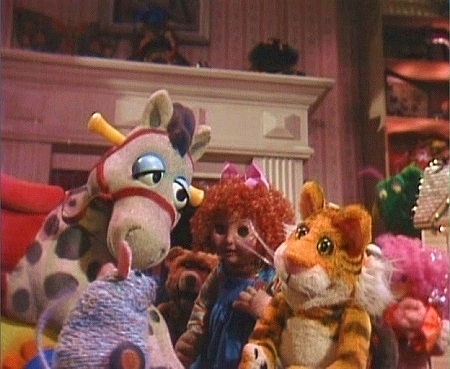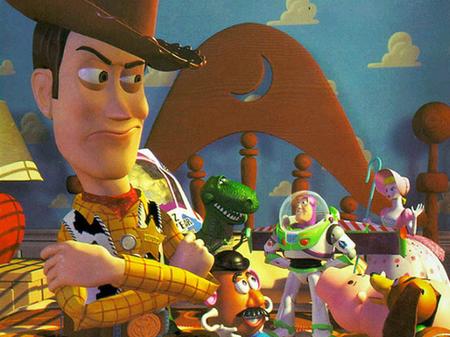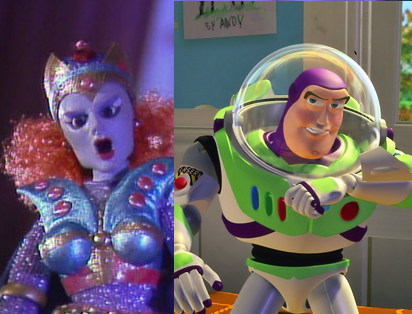
The double feature is cinema appreciation at its most basic. The mere act of pairing two films together – whether the bond be subject matter, central theme, a certain actor or filmmaker, or something outside-the-box conceptual – causes them to take on a different sort of life. A new relationship is formed with the viewer. You pay attention to new aspects and journey down unfamiliar avenues when you view films through Double Feature Goggles. Even when the linking bond is comically tenuous, the double feature magic is there. And I’m the kind of guy who derives just as much pleasure from creating a double feature as I do from watching one. Aside from amusing myself, hopefully I can give some people ideas for their next movie night.
The Double Feature: The Christmas Toy (1986) and Toy Story (1995).
The Connection: Stories revealing the secret lives of toys when us humans aren’t around.
Film 1: The Christmas Toy was a made for TV movie produced by The Jim Henson Company for ABC. Directed by Fraggle Rock episode director Eric Till and written by Laura Phillips, it aired, when else, in December of 1986. The story concerns the community of toys who live in the suburban playroom of a little girl named Jamie. It is Christmas Eve, and Rugby the Tiger (a stuffed animal) becomes nostalgic for the prior Xmas when Jamie unwrapped him, fondly remembering the joy of being Jamie’s favorite Xmas toy. Rugby wants to relive that experience, and schemes to climb inside one of Jamie’s new presents so he can be unwrapped once more. Apple (a horrifying doll that looks like a female Chucky) tries to explain to Rugby that this is simply part of the circle of life, for Apple herself had been supplanted as Jamie’s favorite toy by Rugby the previous year. But Rugby won’t listen. Leaving the playroom is a dangerous act for a toy, for if a human finds one of the toys anywhere except the place where it had been left, that toy will freeze permanently, effectively dying. Well knowing this, Rugby sets out for adventure, joined by Mew, a cat’s toy mouse whom Rugby racistly looks down upon. Under the Christmas tree Rugby opens one of Jamie’s presents, releasing Meteora, Queen of the Asteroids. Meteora is unaware that she is a toy; she thinks she has landed among space aliens. Now the rest of Jamie’s toys must get Meteora back in the box before they are all found by the humans and frozen forever.
To help entice viewers, Christmas Toy was introduced by Kermit the Frog, footage that is no longer available on Lionsgate’s DVD now that Disney owns Kermit. After Jim Henson’s death a short-lived TV series expansion of the TV movie, called Secret Life of Toys, was produced for The Disney Channel in 1994.

Film 2: The movie that started it all for Pixar. 1995’s A Toy Story began life in 1989 when Pixar founder John Lassetter won the Oscar for Best Animated Short Film for Tin Toy. This led to a development deal with Disney, for what Lassetter originally thought might be a TV movie expansion on the Tin Toy world. Updating the lead character from the short (an old-fashioned mechanical one-man band named Tinny) to a space-themed military man named Buzz Lightyear, a new story began to take hold. Billy, the destructive human owner in Tin Toy, was replaced with Andy, a kind and imaginative owner whose toys love him (Billy was thematically re-used as Andy’s neighbor Sid; other elements of Billy can be seen in Toy Story 3‘s rambunctious toddler room). This changed everything, and the story we all now know evolved, about Woody the Cowboy’s jealousy over the new arrival and subsequent playroom dominance of Buzz.
As of 2011, Toy Story has spawned two sequels and two short films, and is the 11th highest growing franchise in film history.

Double Feature Goggles: The story similarities between these two properties are so eerily similar that it is hard not to cry “thieves!” into the night, especially considering Disney’s involvement with both projects. But that’s not what this column is about — plus Toy Story is one of the best films of 1990’s, so who even gives a shit; if Toy Story is what idea theft gets us, than I wish all movies were stolen concepts. Nonetheless, it is the stark similarities between these two films that makes them such an interesting pairing.
Both films were savvy uses of their respective devices: puppets and computer animation. Puppets essentially are toys, at least in outward appearance. Kermit doesn’t look at all like a real frog, but Rugby is a tiger stuffed toy. Doing a story about actual toys is a natural fit for what the Henson Company was doing. Ditto for Pixar. In the early 90’s, it was nearly impossible to create photo-real CGI representations of humans or anything with fur. But creating hard-surfaces and slick shines was entirely possible. So again, doing a story about plastic toys was a natural fit for a company trying to make their first big bang. Christmas Toy‘s puppets, trapped to the lower edge of the frame by necessity, can’t compete with the dynamic movements possible for the Toy Story characters (ditto for the overall camerawork), but both are impressively successful at aesthetically transporting us to the world of toys. Both use the same low-angle approach to make the playroom a monstrous cathedral, and for journeys that leave the playroom to seem dangerous purely in their visual scope.
Toy Story is able to do much more with its concept, plot-wise. For one thing, it is 31 minutes longer. But it also has the ability to leave Andy’s house and the budget to make that departure get epic. Yet, Christmas Toy actually does more dynamic things with its own concept at a core level. In both films, none of the toys can let the humans know they are alive, always scrambling to get back into their places before Andy or someone else comes in through the door. The big difference is that in Toy Story the toys have no expressed reason for doing so. It is simply the way this world is, and it is often fudged with when a toy drops to the ground, or behind something, in a position or location it had not been left in (confounding the humans; how’d this get here?). This mostly seems to be done out of master-servant respect for Andy and the other humans, as evidenced by the fact that the toys break this rule with the cruel Sid, revealing themselves to be sentient for the sole purpose of terrifying him. Christmas Toy, in true Henson fashion, places a dark element of fantasy on its world. Not only will the toys die if they are discovered by a human, but they will die if they don’t return to the exact location where Jamie left them. This leads to an inevitable and rather disturbing moment in which a clown toy is discovered by a human outside of Jamie’s room and is frozen (there may be some crying if you show this to kids). Both films play with the same basic fantasy, though Christmas Toy does so with a concrete plausibility. Your toys are alive when you’re out of the room, but the reason you’ve never caught them is because the moment you do, they freeze and die.
Toy Story nails the variety of toys with greater success than Christmas Toy, but again that is mostly due to budget. Both films have some toy type overlap, and certainly character type overlaps, but Toy Story gets the upper hand with its inclusion of specific toys like Mr. Potato Head and the Green Army Men (though the Barbie-esque toy in Christmas Toy will be familiar to Toy Story trilogy fans). Both films display the kind of inspired creativity associated with their creator companies. Toy Story has more time to get into the minutia of being a toy, but I love the inclusion of Mew the cat toy in Christmas Toy, and the idea that the human toys racistly look down upon him (which naturally leads to a happy change of opinion by the end). It is particularly fishy that both films feature an outer space character as the new toy, though Meteora appears rather late in Christmas Toy‘s runtime — the film’s greater story is actually about Rugby and Mew’s relationship and journey downstairs. The major difference between the two films is tone. Christmas Toy takes place is a slightly frightening world, where toys must be careful at all times, whereas Toy Story‘s drama stems from character conflict between Woody and Buzz, with the dangers of the human world being both secondary and confined to specific sections of the film.
Both are wonderful films for children, in their own ways, and due to Christmas Toy‘s 50-minute length, these two make a very doable Christmas double feature.

Previous Double Features
The Commitments/The Blues Brothers | The Set-Up/High Noon
The Plague Dogs/Secret of NIMH | The Old Dark House/Dolls
The Fury/Firestarter | Alligator/Q
Where the Buffalo Roam/Fear and Loathing in Las Vegas
Mad Love/Body Parts | The Fall/Adventures of Baron Munchausen
Fantasia/Allegro Non Troppo